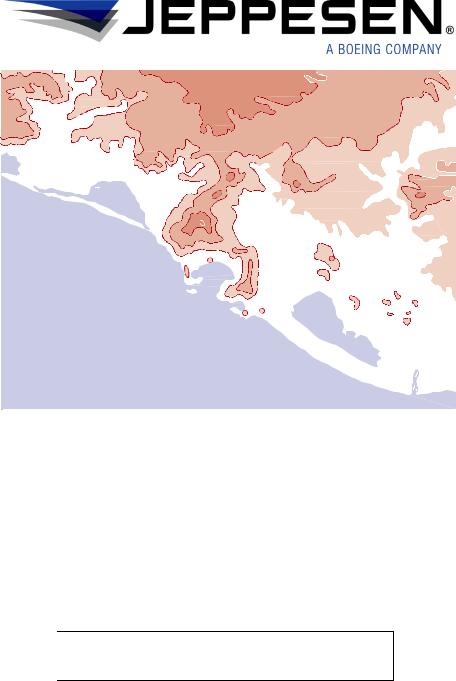
glossary-legends(Джепессен иструкция )
.pdf
INTRODUCTION TO
JEPPESEN
NAVIGATION CHARTS
The chart training guide is published as a service for pilots training with Jeppesen charts. It is intended for reference only and includes some of the most commonly used symbology. Not all symbology is included with this guide. This guide is revised regularly; however, some variance may exist between this guide and current chart services. These may be the result of one or more of the following: chart issuance dates, timely application of changes received from governing agencies and / or the method of representing such information. Some of the charts used in this guide are based on a fictitious location. The chart training guide has been designed as supplementary training material and is not intended for navigation.
For complete product information regarding coverages, services, and pricing, please contact:
Jeppesen Sanderson, Inc. |
Jeppesen GmbH |
55 Inverness Drive East |
Frankfurter Str. 233 |
Englewood, CO 80112-5498 |
63263 Neu-Isenburg |
USA |
Germany |
Tel: 303.799.9090 |
Neu-Isenburg Tel: |
|
+49 6102 5070 |
www.jeppesen.com

25 NOV 11 |
INTRODUCTION |
1 |
GLOSSARY
This glossary provides definitions that are unique and abbreviations commonly used in Jeppesen publications. No attempt has been made to list all the terms of basic aeronautical nomenclature.
Because of the international nature of flying, terms used by the FAA (USA) are included when they differ from International Civil Aviation Organization (ICAO) definitions. A vertical bar, that is omitted on all new pages, tables of contents, tabular listings and graphics, indicates changes.
DEFINITIONS
ACCELERATE STOP DISTANCE AVAILABLE (ASDA) — The length of the take-off run available plus the length of the stopway, if provided.
ACROBATIC FLIGHT — Manoeuvres intentionally performed by an aircraft involving an abrupt change in its attitude, an abnormal attitude, or an abnormal variation in speed.
ADEQUATE VIS REF (Adequate Visual Reference) — Runway markings or runway lighting that provides the pilot with adequate visual reference to continuously identify the take-off surface and maintain directional control throughout the take-off run.
ADS AGREEMENT — An ADS reporting plan which establishes the conditions of ADS data reporting (i.e., data required by the air traffic services unit and frequency of ADS reports which have to be agreed to prior to the provision of the ADS services).
NOTE: The terms of the agreement will be exchanged between the ground system and the aircraft by means of a contract, or a series of contracts.
ADS-C AGREEMENT — A reporting plan which establishes the conditions of ADS-C data reporting (i.e. data required by the air traffic services unit and frequency of ADS-C reports which have to be agreed to prior to using ADS-C in the provision of air traffic services).
NOTE: The terms of the agreement will be exchanged between the ground system and the aircraft by means of a contract, or a series of contracts.
ADS CONTRACT — A means by which the terms of an ADS agreement will be exchanged between the ground system and the aircraft, specifying under what conditions ADS reports would be initiated, and what data would be contained in the reports.
NOTE: The term “ADS contract” is a generic term meaning variously, ADS event contract, ADS demand contract, ADS periodic contract or an emergency mode. Ground forwarding of ADS reports may be implemented between ground systems.
ADVISORY AIRSPACE — An airspace of defined dimensions, or designated route, within which air traffic advisory service is available.
ADVISORY ROUTE (ADR) — A designated route along which air traffic advisory service is available.
NOTE: Air traffic control service provides a much more complete service than air traffic advisory service; advisory areas and routes are therefore not
established within controlled airspace, but air traffic advisory service may be provided below and above control areas.
ADVISORY SERVICE — Advice and information provided by a facility to assist pilots in the safe conduct of flight and aircraft movement.
AERODROME — A defined area on land or water (including any buildings, installations and equipment) intended to be used either wholly or in part for the arrival, departure and surface movement of aircraft.
NOTE: The term “aerodrome” where used in the provisions relating to flight plans and ATS messages is intended to cover also sites other than aerodromes which may be used by certain types of aircraft; e.g., helicopters or balloons.
AERODROME CLIMATOLOGICAL SUMMARY —
Concise summary of specified meteorological elements at an aerodrome, based on statistical data.
AERODROME CLIMATOLOGICAL TABLE — Table providing statistical data on the observed occurrence of one or more meteorological elements at an aerodrome.
AERODROME CONTROL SERVICE — Air traffic control service for aerodrome traffic.
AERODROME CONTROL TOWER — A unit established to provide air traffic control service to aerodrome traffic.
AERODROME ELEVATION — The elevation of the highest point of the landing area.
AERODROME FLIGHT INFORMATION SERVICE (AFIS) — A directed traffic information and operational information service provided within an aerodrome flight information zone, to all radio equipped aircraft, to assist in the safe and efficient conduct of flight.
AERODROME METEOROLOGICAL OFFICE — An office, located at an aerodrome, designated to provide meteorological service for international air navigation.
AERODROME REFERENCE CODE — A simple method for interrelating the numerous specifications concerning the characteristics of aerodromes so as to provide a series of aerodromes facilities that are suitable for the aeroplanes that are intended to operate at the aerodrome. The aerodrome reference code
— code number and letter, which are selected for aerodrome planning purposes, have the meanings assigned to them as indicated in the table below:
© JEPPESEN, 1984, 2011. ALL RIGHTS RESERVED.

2 |
INTRODUCTION |
25 NOV 11 |
GLOSSARY
NOTE: Guidance on planning for aeroplanes with wing spans greater than 80m is given in the ICAO Doc. 9157 “Aerodrome Design Manual,” Parts 1 and 2.
AERODROME TRAFFIC — All traffic on the manoeuvring area of an aerodrome and all aircraft flying in the vicinity of an aerodrome.
NOTE: An aircraft is in the vicinity of an aerodrome when it is in, entering or leaving an aerodrome traffic circuit.
AERODROME TRAFFIC CIRCUIT — The specified path to be flown by aircraft operating in the vicinity of an aerodrome.
AERODROME TRAFFIC FREQUENCY (ATF) — A frequency designated at an uncontrolled airport. An ATF is used to ensure all radio equipped aircraft operating within the area, normally within a 5NM radius of the airport, are listening on a common frequency. The ATF is normally the ground station frequency. Where a ground station does not exist, a common frequency is designated. Radio call sign is that of the ground station, or where no ground station exists, a broadcast is made with the call sign “Traffic Advisory.” Jeppesen charts list the frequency and the area of use when other than the standard 5NM.
AERODROME TRAFFIC ZONE (ATZ) — An airspace of detailed dimensions established around an aerodrome for the protection of aerodrome traffic.
AERONAUTICAL FIXED SERVICE (AFS) — A telecommunication service between specified fixed points provided primarily for the safety of air navigation and for the regular, efficient and economical operation of air services.
AERONAUTICAL FIXED STATION — A station in the aeronautical fixed service.
AERONAUTICAL FIXED TELECOMMUNICATION NETWORK (AFTN) — A world-wide system of aeronautical fixed circuits provided, as part of the aeronautical fixed service, for the exchange of messages and/or digital data between aeronautical fixed stations having the same or compatible communications characteristics.
AERONAUTICAL GROUND LIGHT — Any light specially provided as an aid to air navigation, other than a light displayed on an aircraft.
AERONAUTICAL INFORMATION PUBLICATION (AIP) — A publication issued by or with the authority of a State and containing aeronautical information of a lasting character essential to air navigation.
AERONAUTICAL METEOROLOGICAL STATION — A station designated to make observations and meteorological reports for use in international air navigation.
AERONAUTICAL MOBILE SERVICE — A mobile service between aeronautical stations and aircraft stations, or between aircraft stations, in which survival craft stations may participate; emergency position-indicating radio beacon stations may also participate in this service on designated distress and emergency frequencies.
AERONAUTICAL RADIO, INCORPORATED (ARINC) — An international radio network providing air-to-ground communications available on a subscription (fee) basis.
AERONAUTICAL STATION — A land station in the aeronautical mobile service. In certain instances, an aeronautical station may be located, for example, on board ship or on a platform at sea.
AERONAUTICAL TELECOMMUNICATION SERVICE — A telecommunication service provided for any aeronautical purpose.
AERONAUTICAL TELECOMMUNICATION STATION — A station in the aeronautical telecommunication service.
AIRBORNE COLLISION AVOIDANCE SYSTEM (ACAS) — An aircraft system based on secondary surveillance radar (SSR) transponder signals which operates independently of ground-based equipment to provide advice to the pilot on potential conflicting aircraft that are equipped with SSR transponders.
AIRCRAFT — Any machine that can derive support in the atmosphere from the reactions of the air other than the reactions of the air against the earth’s surface.
AIRCRAFT ADDRESS — A unique combination of 24 bits available for assignment to an aircraft for the purpose of air-ground communications, navigation and surveillance.
AIRCRAFT APPROACH CATEGORY (USA TERPS) — A grouping of aircraft based on a speed of Vref, if specified, or if Vref is not specified, 1.3 VS0 at the maximum certificated landing weight. Vref, VS0, and the maximum certificated landing weight
© JEPPESEN, 1984, 2011. ALL RIGHTS RESERVED.

25 NOV 11 |
INTRODUCTION |
3 |
GLOSSARY
are those values as established for the aircraft by the certification authority of the country of registry. An aircraft shall fit in only one category. If it is necessary to maneuver at speeds in excess of the upper limit of a speed range for a category, the minimums for the next higher category must be used. For example, an aircraft which falls in Category A, but is circling to land at a speed in excess of 91 knots, should use the approach Category B minimums when circling to land. The categories are as follows:
Category A Speed less than 91KT.
Category B Speed 91KT or more but less than 121KT.
Category C Speed 121KT or more but less than 141KT.
Category D Speed 141KT or more but less than 166KT.
Category E Speed 166KT or more.
AIRCRAFT APPROACH CATEGORY (ICAO) — The ICAO table, depicted in the ATC section-200 series, indicates the specified range of handling speeds (IAS in Knots) for each category of aircraft to perform the maneuvers specified. These speed ranges have been assumed for use in calculating airspace and obstacle clearance for each procedure.
AIRCRAFT IDENTIFICATION — A group of letters, figures or combination thereof which is either identical to, or the coded equivalent of, the aircraft call sign to be used in air-ground communications, and which is used to identify the aircraft in ground-ground air traffic services communications.
AIRCRAFT – LARGE AIRCRAFT (LACFT) — Term used when referring to ICAO aircraft category DL standard dimensions:
–wing span – more than 65m/213ft (max 80m/262ft); and/or
–vertical distance between the flight parts of the wheels and the glide path antenna – more than 7m/23ft (max 8m/26ft).
For precision approach procedures, the dimensions of the aircraft are also a factor for the calculation of the OCH.
For category DL aircraft, additional OCA/H is provided, when necessary.
AIRCRAFT OBSERVATION — The evaluation of one or more meteorological elements made from an aircraft in flight.
AIRCRAFT PROXIMITY — A situation in which, in the opinion of a pilot or air traffic services personnel, the distance between aircraft as well as their relative positions and speed have been such that the safety of the aircraft involved may have been compromised. An aircraft proximity is classified as follows:
Risk of Collision — The risk classification of an aircraft proximity in which serious risk of collision has existed.
Safety not Assured — The risk classification of an aircraft proximity in which the safety of the aircraft may have been compromised.
No Risk of Collision — The risk classification of an aircraft proximity in which no risk of collision has existed.
Risk not Determined — The risk classification of an aircraft proximity in which insufficient information was available to determine the risk involved, or inconclusive or conflicting evidence precluded such determination.
AIRCRAFT STATION — A mobile station in the aeronautical mobile service, other than a survival craft station, located on board an aircraft.
AIR DEFENSE IDENTIFICATION ZONE (ADIZ) —
The area of airspace over land or water, extending upward from the surface, within which the ready identification, the location, and the control of aircraft are required in the interest of national security.
AIR-GROUND COMMUNICATION — Two-way communication between aircraft and stations or locations on the surface of the earth.
AIR-GROUND CONTROL RADIO STATION —
An aeronautical telecommunication station having primary responsibility for handling communications pertaining to the operation and control of aircraft in a given area.
AIRMET INFORMATION — Information issued by a meteorological watch office concerning the occurrence or expected occurrence of specified en route weather phenomena which may affect the safety of low-level aircraft operations and which was not already included in the forecast issued for low-level flights in the flight information region concerned or sub-area thereof.
AIRPORT — An area on land or water that is used or intended to be used for the landing and take-off of aircraft and includes its buildings and facilities, if any.
AIRPORT ELEVATION/FIELD ELEVATION — The highest point of an airports usable runways measured in feet from mean sea level. In a few countries, the airport elevation is determined at the airport reference point.
AIRPORT REFERENCE POINT (ARP) — A point on the airport designated as the official airport location.
AIRPORT SURVEILLANCE RADAR (ASR) —
Approach control radar used to detect and display an aircraft’s position in the terminal area. ASR provides range and azimuth information but does not provide elevation data. Coverage of the ASR can extend up to 60 miles.
AIRPROX — The code word used in an air traffic incident report to designate aircraft proximity.
AIR-REPORT — A report from an aircraft in flight prepared in conformity with requirements for position and operational and/or meteorological reporting.
NOTE: Details of the AIREP form are given in PANSATM (Doc 4444) and ATC section.
AIR-TAXIING — Movement of a helicopter/VTOL above the surface of an aerodrome, normally in ground effect and at a ground speed normally less than 20KT (37kmh).
© JEPPESEN, 1984, 2011. ALL RIGHTS RESERVED.

4 |
INTRODUCTION |
25 NOV 11 |
GLOSSARY
NOTE: The actual height may vary, and some helicopters may require air-taxiing above 25ft (8m) AGL to reduce ground effect turbulence or provide clearance for cargo slingloads.
AIR-TO-GROUND COMMUNICATION — One-way communication from aircraft to stations or locations on the surface of the earth.
AIR TRAFFIC — All aircraft in flight or operating on the manoeuvring area of an aerodrome.
AIR TRAFFIC ADVISORY SERVICE — A service provided within advisory airspace to ensure separation, in so far as practical, between aircraft which are operating on IFR flight plans.
AIR TRAFFIC CONTROL ASSIGNED AIRSPACE (ATCAA) — Airspace of defined vertical/lateral limits, assigned by ATC, for the purpose of providing air traffic segregation between the specified activities being conducted within the assigned airspace and other IFR air traffic.
AIR TRAFFIC CONTROL CLEARANCE — Authorization for an aircraft to proceed under conditions specified by an air traffic control unit.
NOTE 1: For convenience, the term “air traffic control clearance” is frequently abbreviated to “clearance” when used in appropriate contexts.
NOTE 2: The abbreviated term “clearance” may be prefixed by the words “taxi,” “take-off,” “departure,” “en route,” “approach” or “landing” to indicate the particular portion of flight to which the air traffic control clearance relates.
AIR TRAFFIC CONTROL INSTRUCTION — Directives issued by air traffic control for the purpose of requiring a pilot to take a specific action.
AIR TRAFFIC CONTROL SERVICE — A service provided for the purpose of:
a.preventing collisions:
1.between aircraft; and
2.on the manoeuvring area between aircraft and obstructions; and
b.expediting and maintaining an orderly flow of air traffic.
AIR TRAFFIC CONTROL UNIT — A generic term meaning variously, area control centre, approach control office or aerodrome control tower.
AIR TRAFFIC SERVICE (ATS) — A generic term meaning variously, flight information service, alerting service, air traffic advisory service, air traffic control service (area control service, approach control service or aerodrome control service).
AIR TRAFFIC SERVICES AIRSPACES — Airspaces of defined dimensions, alphabetically designated, within which specific types of flights may operate and for which air traffic services and rules of operation are specified.
NOTE: ATS airspaces are classified as Class “A” to “G.”
AIR TRAFFIC SERVICES REPORTING OFFICE —
A unit established for the purpose of receiving reports concerning air traffic services and flight plans submitted before departure.
NOTE: An air traffic services reporting office may be established as a separate unit or combined with an existing unit, such as another air traffic services unit, or a unit of the aeronautical information service.
AIR TRAFFIC SERVICES (ATS) ROUTE — A specified route designated for channeling the flow of traffic as necessary for provision of air traffic services.
NOTE: The term “ATS Route” is used to mean variously, airway, advisory route, controlled or uncontrolled route, arrival or departure route, etc.
AIR TRAFFIC SERVICES (ATS) ROUTE (USA) —
A generic term that includes ‘VOR Federal airways’, ‘colored Federal airways’, ‘jet routes’, ‘Military Training Routes’, ‘named routes’, and ‘RNAV routes.’
AIR TRAFFIC SERVICES UNIT — A generic term meaning variously, air traffic control unit, flight information centre or air traffic services reporting office.
AIRWAY (ICAO) — A control area or portion thereof established in the form of a corridor equipped with radio navigation aids.
AIRWAY (USA) — A Class “E” airspace area established in the form of a corridor, the centerline of which is defined by radio navigational aids.
ALERFA — The code word used to designate an alert phase.
ALERT AREA (USA) — [see SPECIAL USE AIRSPACE (SUA)].
ALERTING SERVICE — A service provided to notify appropriate organizations regarding aircraft in need of search and rescue aid, and assist such organizations as required.
ALERT PHASE — A situation wherein apprehension exists as to the safety of an aircraft and its occupants.
ALLOCATION, ALLOCATE — Distribution of frequencies, SSR Codes, etc. to a State, unit or service, Distribution of 24-bit aircraft addresses to a State or common mark registering authority.
ALONG TRACK DISTANCE — The distance measured from a point-in-space by systems using area navigation reference capabilities that are not subject to slant range errors.
ALPHANUMERIC CHARACTERS (Alphanumerics) — A collective term for letters and figures (digits).
ALTERNATE AERODROME (ICAO) — An aerodrome to which an aircraft may proceed when it becomes either impossible or inadvisable to proceed to or to land at the aerodrome of intended landing. Alternate aerodromes include the following:
Take-Off Alternate — An alternate aerodrome at which an aircraft can land should this become necessary shortly after take-off and it is not possible to use the aerodrome of departure.
En Route Alternate — An aerodrome at which an aircraft would be able to land after experiencing an abnormal or emergency condition while en route.
Destination Alternate — An alternate aerodrome to which an aircraft may proceed should it become impossible or inadvisable to land at the aerodrome of intended landing.
© JEPPESEN, 1984, 2011. ALL RIGHTS RESERVED.

3 AUG 12 |
INTRODUCTION |
5 |
|
GLOSSARY |
|
NOTE: The aerodrome from which a flight departs may also be an en route or a destination alternate aerodrome for that flight.
ETOPS En Route Alternate — A suitable and appropriate alternate aerodrome at which an aeroplane would be able to land after experiencing an engine shutdown or other abnormal or emergency condition while en route in an ETOPS operation.
ALTERNATE AIRPORT (USA) — An airport at which an aircraft may land if a landing at the intended airport becomes inadvisable.
ALTIMETER SETTING — The barometric pressure reading used to adjust a pressure altimeter for variations in existing atmospheric pressure or to the standard altimeter setting (29.92 inches of mercury, 1013.2 hectopascals or 1013.2 millibars).
QFE — The atmospheric pressure setting which, when set in the aircraft’s altimeter, will cause the altimeter to read zero when at the reference datum of the airfield.
QNE — The constant atmospheric pressure related to a reference datum of 29.92 inches of mercury or 1013.25 hectopascals or 1013.25 millibars, used for expressing flight levels.
QNH — The atmospheric pressure setting which, when set in the aircraft’s altimeter, will cause the altimeter to read altitudes referenced to mean sea level.
ALTITUDE (ICAO) — The vertical distance of a level, a point, or an object considered as a point, measured from Mean Sea Level (MSL).
ALTITUDE (USA) — The height of a level, point or object measured in feet Above Ground Level (AGL) or from Mean Sea Level (MSL).
a.AGL Altitude — Altitude expressed in feet measured above ground level (QFE).
b.MSL Altitude — Altitude expressed in feet measured from mean sea level (QNH).
c.Indicated Altitude — The Altitude as shown by an altimeter. On a pressure barometric altimeter it is altitude as shown uncorrected for instrument error and uncompensated for variation from standard atmospheric conditions.
APPROACH BAN — An approach procedure, for which continuation is prohibited beyond a specific point, and or specified height, if the reported visibility or RVR is below the minimum specified for that approach.
APPROACH CONTROL OFFICE — A unit established to provide air traffic control service to controlled flights arriving at, or departing from, one or more aerodromes.
APPROACH CONTROL SERVICE — Air traffic control service for arriving or departing controlled flights.
APPROACH CONTROL UNIT — A unit established to provide air traffic control service to controlled flights arriving at, or departing from, one or more aerodromes.
APPROACH FUNNEL — A specified airspace around a nominal approach path within which an aircraft approaching to land is considered to be making a normal approach.
APPROACH PROCEDURE WITH VERTICAL GUIDANCE (APV) — [see INSTRUMENT APPROACH PROCEDURE (IAP)].
APPROACH SEQUENCE — The order in which two or more aircraft are cleared to approach to land at the aerodrome.
APPROPRIATE ATS AUTHORITY — The relevant authority designated by the State responsible for providing air traffic services in the airspace concerned.
APPROPRIATE AUTHORITY —
a.Regarding flight over the high seas: The relevant authority of the State of Registry.
b.Regarding flight other than over the high seas: The relevant authority of the State having sovereignty over the territory being overflown.
APRON — A defined area, on a land aerodrome, intended to accommodate aircraft for purposes of loading or unloading passengers, mail or cargo, fueling, parking or maintenance.
AREA CONTROL CENTRE — A unit established to provide air traffic control service to controlled flights in control areas under its jurisdiction.
AREA CONTROL SERVICE — Air traffic control service for controlled flights in control areas.
AREA MINIMUM ALTITUDE (AMA) — The minimum altitude to be used under instrument meteorological conditions (IMC), that provides a minimum obstacle clearance within a specified area, normally formed by parallels and meridians.
AREA NAVIGATION/RNAV — A method of navigation which permits aircraft operation on any desired flight path within the coverage of the station-refer- enced navigation aids or within the limits of the capability of self-contained aids, or a combination of these.
AREA NAVIGATION ROUTE — An ATS route established for the use of aircraft capable of employing area navigation.
ARRIVAL ROUTES — Routes on an instrument approach procedure by which aircraft may proceed from the enroute phase of flight to the initial approach fix.
ASSIGNMENT, ASSIGN — Distribution of frequencies to stations. Distribution of SSR Codes or 24-bit addresses to aircraft.
ATIS — ASOS INTERFACE — A switch that allows ASOS weather observations to be appended to the ATIS broadcast, making weather information available on the same (ATIS) frequency H24. When the tower is open, ATIS information and the hourly weather will be broadcast. When the tower is closed, one-minute weather information updates are broadcast, and the controller can add overnight ATIS information to the ASOS automated voice weather message.
ATS ROUTE — A specified route designed for channeling the flow of traffic as necessary for the provision of air traffic services.
© JEPPESEN, 1984, 2012. ALL RIGHTS RESERVED.

6 |
INTRODUCTION |
3 AUG 12 |
|
GLOSSARY |
|
NOTE 1: The term “ATS route” is used to mean variously, airway, advisory route, controlled or uncontrolled route, arrival or departure route, etc.
NOTE 2: An ATS route is defined by route specifications which include an ATS route designator, the track to or from significant points (way-points), distance between significant points, reporting requirements and, as determined by the appropriate ATS authority, the lowest safe altitude.
ATS SURVEILLANCE SERVICE — A term used to indicate a service provided directly by means of an ATS surveillance system.
ATS SURVEILLANCE SYSTEM — A generic term meaning variously, ADS-B, PSR, SSR or any comparable ground-based system that enables the identification of aircraft.
NOTE: A comparable ground-based system is one that has been demonstrated, by comparative assessment or other methodology, to have a level of safety and performance equal to or better than monopulse SSR.
AUTOMATIC DEPENDENT SURVEILLANCE (ADS) — A surveillance technique, in which aircraft automatically provide, via a data link, data derived from on-board navigation and position fixing systems, including aircraft identification, four-dimen- sional position and additional data as appropriate.
AUTOMATIC DEPENDENT SURVEILLANCE — BROADCAST (ADS-B) — A means by which aircraft, aerodrome vehicles and other objects can automatically transmit and/or receive data such as identification, position and additional data, as appropriate, in a broadcast mode via a data link.
AUTOMATIC DEPENDENT SURVEILLANCE — CONTRACT (ADS-C) — A means by which the terms of an ADS-C agreement will be exchanged between the ground system and the aircraft, via a data link, specifying under what conditions ADS-C reports would be initiated, and what data would be contained in the reports.
NOTE: The abbreviated term “ADS” contract is commonly used to refer to ADS event contract, ADS demand contract or an emergency mode.
AUTOMATIC TERMINAL INFORMATION SERVICE (ATIS) — The automatic provision of current, routine information to arriving and departing aircraft throughout 24 hours or a specified portion thereof:
–Data link-automatic terminal information service (D-ATIS). The provision of ATIS via data link.
–Voice-automatic terminal information service (Voice-ATIS). The provision of ATIS by means of continuous and repetitive voice broadcasts.
AUTOMATED SURFACE OBSERVATION SYSTEM (ASOS) — The Automated Surface Observation System, in the United States, is a surface weather observing system implemented by the National Weather Service, the Federal Aviation Administration and the Department of Defense. It is designed to support aviation operations and weather forecast activities. The ASOS provides continuous minute-by-minute observations and performs the basic observing functions necessary to generate an aviation routine weather report (METAR) and other
aviation weather information. ASOS information may be transmitted over a discrete VHF radio frequency or the voice portion of a local navaid.
AUTOMATED WEATHER OBSERVING SYSTEM (AWOS) — An automated weather reporting system which transmits local real-time weather data directly to the pilot.
AWOS-A Only reports altimeter setting. AWOS-A/V Reports altimeter setting plus visibility.
AWOS-1 Usually reports altimeter setting, wind data, temperature, dewpoint and density altitude.
AWOS-2 Reports same as AWOS-1 plus visibility.
AWOS-3 Reports the same as AWOS-2 plus cloud/ceiling data.
AUTOMATED WEATHER SENSOR SYSTEM (AWSS) — A surface weather observing system similar to AWOS and ASOS, providing all the weather information furnished by ASOS systems. The AWSS sensor suite automatically collects, measures, processes, and broadcasts surface weather data including altimeter setting, temperature and dew point, cloud height and coverage, visibility, present weather (rain, drizzle, snow), rain accumulation, freezing rain, thunderstorms, fog, mist, haze, freezing fog, as well as wind speed, direction, and gusts.
BALKED LANDING — A landing manoeuvre that is unexpectedly discontinued below DA(H)/MDA(H) or beyond MAP.
BASE TURN — A turn executed by the aircraft during the initial approach between the end of the outbound track and the beginning of the intermediate or final approach track. The tracks are not reciprocal.
NOTE: Base turns may be designated as being made either in level flight or while descending, according to the circumstances of each individual procedure.
BLIND TRANSMISSION — A transmission from one station to another station in circumstances where two-way communication cannot be established but where it is believed that the called station is able to receive the transmission.
BRAKING ACTION (GOOD, FAIR, POOR, NIL) —
A report of conditions on the airport movement area providing a pilot with a degree/quality of braking that might be expected. Braking action is reported in terms of good, fair, poor, or nil.
BRIEFING — Oral commentary on existing and/or expected conditions.
BROADCAST — A transmission of information relating to air navigation that is not addressed to a specific station or stations.
CARDINAL ALTITUDES OR FLIGHT LEVELS —
“Odd” or “Even” thousand-foot altitudes or flight levels; e.g., 5000, 6000, 7000, FL60, FL250, FL260, FL270.
CATCH POINT — A fix/waypoint that serves as a transition point from the high altitude waypoint navigation structure to the low altitude structure or an arrival procedure (STAR).
© JEPPESEN, 1984, 2012. ALL RIGHTS RESERVED.

25 NOV 11 |
INTRODUCTION |
7 |
GLOSSARY
CEILING (ICAO) — The height above the ground or water of the base of the lowest layer of cloud below 6000m (20,000ft) covering more than half the sky.
CEILING (USA) — The height above the earth’s surface of the lowest layer of clouds or obscuring phenomena that is reported as “broken”, “overcast”, or “obscuration”, and not classified as “thin”, or “partial”.
CHANGE-OVER POINT — The point at which an aircraft navigating on an ATS route segment defined by reference to very high frequency omnidirectional radio ranges is expected to transfer its primary navigational reference from the facility behind the aircraft to the next facility ahead of the aircraft.
NOTE: Change-over points are established to provide the optimum balance in respect of signal strength and quality between facilities at all levels to be used and to ensure a common source of azimuth guidance for all aircraft operating along the same portion of a route segment.
CHART CHANGE NOTICES — Jeppesen Chart Change Notices include significant information changes affecting Enroute, Area, and Terminal charts. Entries are published until the temporary condition no longer exists, or until the permanent change appears on revised charts. Enroute chart numbers/panel numbers/letters and area chart identifiers are included for each entry in the enroute portion of the Chart Change Notices. To avoid duplication of information in combined Enroute and Terminal Chart Change Notices, navaid conditions, except for ILS components, are listed only in the Enroute portion of the Chart Change Notices. All times are local unless otherwise indicated. Vertical bars indicate new or revised information. Chart Change Notices are only an abbreviated service. Always ask for pertinent NOTAMs prior to flight.
CIRCLING APPROACH / CIRCLE-TO-LAND MANEUVER — An extension of an instrument approach procedure which provides for visual circling of the aerodrome prior to landing.
CLEARANCE LIMIT — The point to which an aircraft is granted an air traffic control clearance.
CLEARWAY — An area beyond the take-off runway under the control of airport authorities within which terrain or fixed obstacles may not extend above specified limits. These areas may be required for certain turbine-powered operations and the size and upward slope of the clearway will differ depending on when the aircraft was certified.
CLOUD OF OPERATIONAL SIGNIFICANCE — A cloud with the height of cloud base below 5000ft (1500m) or below the highest minimum sector altitude, whichever is greater, or a cumulonimbus cloud or a towering cumulus cloud at any height.
CODE (SSR CODE) — The number assigned to a particular multiple pulse reply signal transmitted by a transponder in Mode A or Mode C.
COMMON TRAFFIC ADVISORY FREQUENCY (CTAF) (USA) — A frequency designed for the purpose of carrying out airport advisory practices while operating to or from an uncontrolled airport. The CTAF may be a UNICOM, Multicom, FSS, or tower frequency.
COMMUNITY AERODROME RADIO STATION (CARS) — An aerodrome radio that provides weather, field conditions, accepts flight plans and position reports.
COMPULSORY REPORTING POINTS — Reporting points which must be reported to ATC. They are designated on aeronautical charts by solid triangles or filed in a flight plan as fixes selected to define direct routes. These points are geographical locations which are defined by navigation aids/fixes. Pilots should discontinue position reporting over compulsory reporting points when informed by ATC that their aircraft is in “radar contact.”
COMPUTER — A device which performs sequences of arithmetical and logical steps upon data without human intervention.
NOTE: When the word “computer” is used in this document it may denote a computer complex, which includes one or more computers and peripheral equipment.
CONDITIONAL ROUTES (CDR) (Europe) —
Category 1,2,3.
Category 1: Permanently plannable CDR during designated times.
Category 2: Plannable only during times designated in the Conditional Route Availability Message (CRAM) published at 1500 for the 24 hour period starting at 0600 the next day.
Category 3: Not plannable. Usable only when directed by ATC.
CONTROL AREA (ICAO) — A controlled airspace extending upwards from a specified limit above the earth.
CONTROLLED AERODROME — An aerodrome at which air traffic control service is provided to aerodrome traffic.
NOTE: The term “controlled aerodrome” indicates that air traffic control service is provided to aerodrome traffic but does not necessarily imply that a control zone exists.
CONTROLLED AIRSPACE — An airspace of defined dimensions within which air traffic control service is provided to IFR flights and to VFR flights in accordance with the airspace classification.
NOTE: Controlled airspace is a generic term which covers ATS airspace Classes “A”, “B”, “C”, “D”, and “E”.
CONTROLLED FIRING AREA (USA) — [see SPECIAL USE AIRSPACE (SUA)].
CONTROLLED FLIGHT — Any flight which is subject to an air traffic control clearance.
CONTROLLER-PILOT DATA LINK COMMUNICATIONS (CPDLC) — A means of communication between controller and pilot, using data link for ATC communications.
CONTROL ZONE (CTR) (ICAO) — A controlled airspace extending upwards from the surface of the earth to a specified upper limit.
© JEPPESEN, 1984, 2011. ALL RIGHTS RESERVED.

8 |
INTRODUCTION |
25 NOV 11 |
GLOSSARY
COURSE —
a.The intended direction of flight in the horizontal plane measured in degrees from north.
b.The ILS localizer signal pattern usually specified as front course or back course.
c.The intended track along a straight, curved, or segmented MLS path.
CRITICAL HEIGHT — Lowest height in relation to an aerodrome specified level below which an approach procedure cannot be continued in a safe manner solely by the aid of instruments.
CRUISE CLIMB — An aeroplane cruising technique resulting in a net increase in altitude as the aeroplane mass decreases.
CRUISING LEVEL — A level maintained during a significant portion of a flight.
CURRENT FLIGHT PLAN (CPL) — The flight plan, including changes, if any, brought about by subsequent clearances.
DANGER AREA (ICAO) — [see SPECIAL USE AIRSPACE (SUA)].
DATA CONVENTION — An agreed set of rules governing the manner or sequence in which a set of data may be combined into a meaningful communication.
DATA LINK COMMUNICATIONS — A form of communication intended for the exchange of messages via a data link.
DATA LINK INITIATION CAPABILITY (DLIC) —
A data link application that provides the ability to exchange addresses, names and version numbers necessary to initiate data link applications.
DEAD RECKONING (DR) NAVIGATION — The estimating or determining of position by advancing an earlier known position by the application of direction, time and speed data.
DECISION ALTITUDE (DA) or DECISION HEIGHT (DH) (ICAO) — A specified altitude or height in the precision approach or approach with vertical guidance at which a missed approach must be initiated if the required visual reference to continue the approach has not been established.
NOTE:
a.Decision altitude (DA) is referenced to mean sea level (MSL) and decision height (DH) is referenced to the threshold elevation.
b.The required visual reference means that section of the visual aids or of the approach area which should have been in view for sufficient time for the pilot to have made an assessment of the aircraft position and rate of change of position, in relation to the desired flight path. In Category III operations with a decision height the required visual reference is that specified for the particular procedure and operation.
c.For convenience where both expressions are used they may be written in the form “decision altitude/height” and abbreviated “DA/H.”
DECISION ALTITUDE/HEIGHT (DA/H) (FAA) — Is a specified altitude/height in an instrument approach procedure at which the pilot must decide whether to initiate an immediate missed approach if the pilot
does not see the required visual reference, or to continue the approach. Decision altitude/height is expressed in feet above mean sea level/ground level.
NOTE: Jeppesen approach charts use the abbreviation DA(H). The decision altitude “DA” is referenced to mean sea level (MSL) and the parenthetical decision height (DH) is referenced to the TDZE or threshold elevation. A DA(H) of 1440ft (200ft is a Decision Altitude of 1440ft and a Decision Height of 200ft.
DEPARTURE CLEARANCE VIA DATA LINK (DCL) — Provides assistance for requesting and delivering information and clearance, with the objective of reducing aircrew and controller workload. The DCL service shall be initiated by the aircrew at a suitable time between Ti and Tt where:
Ti – the earliest time at which a DCL service can be initiated;
Tt – the latest time after which an aircrew, having not completed the DCL service, is still able to receive by voice procedures and in due time, the vocal departure clearance.
The third time parameter of the DCL acknowledge procedure is T1 where:
T1 – timer implemented in the ATS ground system between the sending by ATS ground system of the DCL clearance message and the reception by it of the read-back of DCL clearance message.
DEPENDENT PARALLEL APPROACHES — Simultaneous approaches to parallel or near-parallel instrument runways where radar separation minima between aircraft on adjacent extended runway centre lines are prescribed.
DETRESFA — The code word used to designate a distress phase.
DIRECT ROUTE - D — A requested route published on a Jeppesen Enroute or Area chart to assist pilots who have previous knowledge of acceptance of these routes by ATC. Use of a Direct route may require prior ATC approval and may not provide ATC or Advisory services, or be acceptable in flight plans.
DISCRETE CODE — A four-digit SSR Code with the last two digits not being “00.”
DISPLACED THRESHOLD — A threshold that is located at a point on the runway other than the designated beginning of the runway.
DISTRESS — A condition of being threatened by serious and/or imminent danger and of requiring immediate assistance.
DISTRESS PHASE — A situation wherein there is a reasonable certainty that an aircraft and its occupants are threatened by grave and imminent danger or require immediate assistance.
DME DISTANCE — The line of sight distance (slant range) from the source of a DME signal to the receiving antenna.
© JEPPESEN, 1984, 2011. ALL RIGHTS RESERVED.
